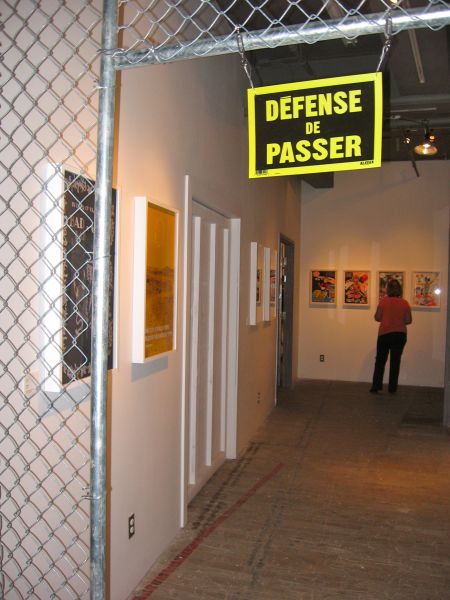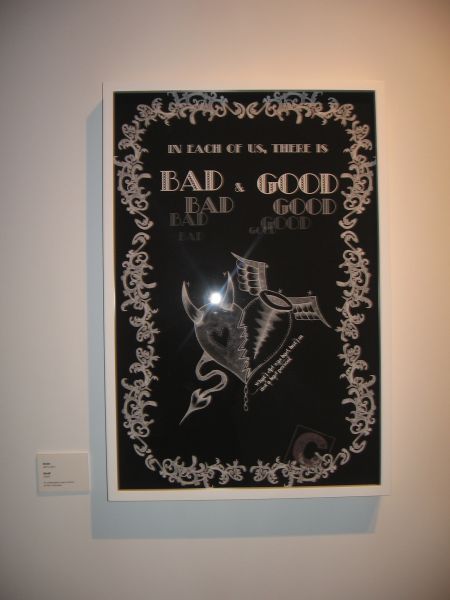Prison: a place whose very name incites a chill at the thought of being behind bars. But what if the conditions of incarceration could be understood without a criminal record? Agir: art des femmes en prison allows that very experiencing of the haunting realities of female incarceration in a unique multi-media exhibit.
“L’art est un engage. Les femmes l’utilisent à merveille. Elles l’ont besoin pour s’exprimer,” exhibitor Geneviève Fortin told the crowd at the show’s opening May 26.
Fortin was once a resident of the Thérèse Casgrain Halfway House. Now, she is in the process of obtaining a university degree and is running her own art workshop for formerly incarcerated women. Her success story is largely thanks to the Agir par l’imaginaire project.
In 2007, the Société Elizabeth Fry du Québec (SEFQ) teamed up with Engrenage Noir / LEVIER. The SEFQ encourages the social reintegration of incarcerated women and raises awareness as to the condition of their lives both within and without prison walls, while its partner is a non-profit organization that uses community and activist art in retaliation against poverty and social inequality. Together, they formed Agir par l’imaginaire: a co-collaborative art project involving 49 incarcerated women and eight professional artists.
Between 2008 and 2010, workshops were held at the Maison Tanguay provincial prison, Joliette Institution, Institut Philippe-Pinel psychiatric facility and the Thérèse Casgrain Halfway House.
“Cette collaboration va au-delà du simple partage de savoir, de notions à apprendre et d'habilités à intégrer,” said SEFQ general director Ruth Gagnon.“Il s'agit du résultat de rencontres où chacun apprend de l'univers de l'autre afin de créer des oeuvres marquantes et créantes de réalisme et d'authenticité."
The result: 35 videos, audio recordings, animated films, photographs, posters and poetry amplifying the harrowing voices of women who are normally silenced by the penal system.
Interdisciplinary artist Émilie Monnet described her participation in the Agir project as “une expérience qui m’a fait découvrir des femmes généreuses et sensibles, pleinement investies dans le processus créative, talentueuses, et avec énormément de choses à dire."
Many of the sentiments these women expressed in their art, Monnet went on to explain, echoed her own work’s inspiration: dreams, suffering, and hope for a better world.
"Il n'y a pas de grandes différences entre nous; nous nous rejoindrons à plusieurs niveaux,” she said.
The similarities Monnet discovered between her and the incarcerated women with whom she worked highlight one of the exhibit’s simple yet significant messages: prisoners are people, too.
“I had the opportunity to show two sides: who I am and what I am living,” says Adina in Nous sommes votre mirroir, a series of video interviews with prisoners produced by Monnet. It is one of several pieces expressing the optimistic revelations, such as realizing self-worth or redefining self-identity, bred from producing art in prison.
“C’est grâce à art Agir que je suis qui je suis,” said exhibitor Julie Chantale St-Jean.
St-Jean attended the Agir exhibit opening along with over 15 other once-incarcerated participants. The intermingling of visitors and former inmates demonstrated the power of art therapy in the process of reintegration.
But much of the artwork surrounding the event's attendees is a reminder that prison without Agir is creatively and emotionally stifling.
Caged Songs is a series of video shorts with various participants’ interpretations of their day-to-day lives defined by stress, loneliness, boredom. The flat screen TV from which the piece is projected must be viewed from behind a chain-link fence, as if peering into the prison itself.
One Day Done, A Hundred Left to Go is an audio recording of the sounds of prison: slamming doors, locks closing, incessant murmurs. The noises are played in a small room containing only a speaker. Listeners have no other choice but to pay attention to the piece enveloping them.
Like the heavily curtained enclave of One Day Done, much of the exhibit is claustrophobic and uncomfortable, that is, wonderfully executed.
Housed on the second floor of the Eastern Bloc Gallery, the venue mimics the look of a prison: whitewashed brick walls, beaten-up floorboards and metallic doors. Visitors must pass through a fence portal hung with a “Défense de passer” sign before navigating the exhibit’s dimly lit and narrow spaces.
This aesthetic blurs the lines between exhibition room and prison in much the same way that the pieces could at once pass for art, at another for documentary.
Devora Neumark, co-director of Engrenage Noir / LEVIER, hopes the raw nature of the exhibit’s material will illicit a “multiplicity of reactions,” one of which is responsibility. According to Neumark, as taxpaying contributors to the penal system, most Canadians have a stake in the lives of incarcerated women. The Agir exhibit forces visitors to view inmates as a consequence of society’s failings and question whether the Canadian penal system as it stands is the best solution for criminality.
These issues, including possible alternatives to prison, the condition of incarcerated women in Canada, and the use of art therapy for prisoners, will be addressed during a series of roundtable discussions at the exhibit.
When asked if the Agir project will be repeated, Neumark responded that the project must be critically assessed once the exhibit is dismounted. Then, organizers can determine how to effectively continue. One thing was for certain: “the power of the creative process has been significant to a great majority of women,” she said.
St-Jean couldn’t agree more:
“Je suis heureuse que les gens puissent exprimer leur souffrance…sans avoir de conséquences,” she said before correcting herself and adding: “Oui, une belle consequence—une consequence artistique qui nous amenait à nous décourvrir et d’avancer.”
The Agir: art des femmes en prison exhibit runs May 26, 2011 to June 16, 2011 at the Eastern Bloc Gallery located at 7240 Clark Street, Montreal. Admission is free.
Roundtable discussions will be held on June 2, June 9 and June 16 at 7 p.m. at the Eastern Bloc Gallery. Details of the discussion topics can be found on the exhibit’s web site.





